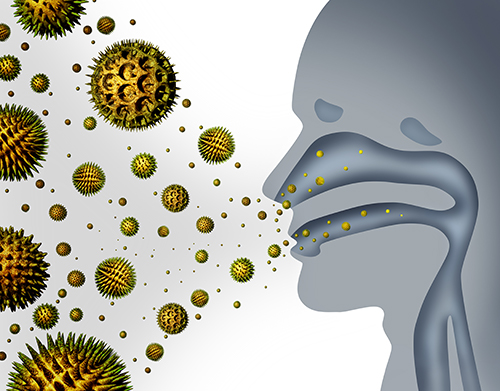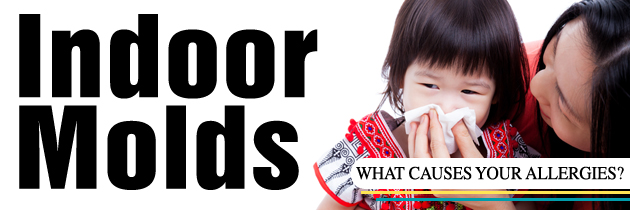Do you suffer from allergies but don’t know what you’re allergic to? Do you often experience itching, sneezing or runny nose, but can’t figure out the cause? Do your symptoms worsen when you are indoors? If the answer to these questions is yes, then it is likely that your troubles are caused by molds growing in your home. Let’s find out how these indoor molds are related to your allergy symptoms.
Indoor Molds and Allergies – What Research Says
Indoor molds include Aspergillus, Alternaria, Penicillum and Cladosporium species of fungi and commonly grow in moist, damp places such as kitchens or bathrooms. They are notorious for causing respiratory diseases especially allergies.

In a review of scientific studies on molds, researchers from California found that indoor molds were associated with allergic diseases of the respiratory tract, which could progress to asthma1. Similarly, researchers from Germany explored the relationship between indoor molds and allergy and concluded that long-term indoor mold exposure was not only associated with allergy to molds themselves, but also increased the risk of developing allergies to other inhalants,2 such as dust and mites. These findings were further corroborated by a study which reported that molds often cause3 allergy related diseases such as asthma, allergic rhinitis and allergic bronchopulmonary aspergillosis.
Although very rare, exposure to large amount of indoor molds can cause severe anaphylactic allergic reaction4 in some individuals, which can even result in death.
How Indoor Molds Cause Allergy?
You’re probably wondering how these harmless-looking molds can cause allergies and asthma. Well, the real culprits are spores produced by these molds, which can spread throughout the air inside your home. Once a susceptible person inhales these spores, they are recognized as foreign objects by the body, which responds by producing antibodies5, especially IgE, against them. When the person inhales the spores again, the antibodies react with them. As a result of this reaction, the airway releases chemicals that are responsible for symptoms, such as sneezing, itching, and a runny or blocked nose.

Repeated inhalation of these mold spores over several months and years can result in hypersensitivity and inflammation of the respiratory airways, which culminates in the form of asthma. This was confirmed by a large European study6, which reported that individuals living in houses with water damage, or with mold growth have a high risk of developing asthma. Further evidence incriminating indoor molds in asthma causation was provided by Finnish researchers7 who reviewed 16 studies on the causative factors of asthma and found that greater dampness, visible mold and mold odor were all associated with asthma development.
Patterns of Mold Allergy
Since most indoor molds and their spores are present throughout the year, these symptoms usually occur regularly, instead of in a particular season. However, spores of some molds, particularly the Aspergillus species, increase in the rainy season because of increased dampness and frequent winds in that season. People allergic to these molds suffer from severe symptoms during the rainy season, especially after thunderstorms. These cases are often referred to as “thunderstorm asthma”
The scientific evidence provided above clearly shows that molds aren’t as harmless as they appear. In fact, it is likely that they’re the root cause of your allergy problems. Treating your allergies may be as simple as removing the molds growing in your home.
For professional mold removal services in Alexandria VA and Washington DC area, call the mold remediation experts of ServiceMaster NCR at (855) 957-6627!
References
1. Mendell MJ, Mirer AG, Cheung K, Tong M, Douwes J. Respiratory and allergic health effects of dampness, mold, and dampness-related agents: a review of the epidemiologic evidence. Environ Health Perspect. 2011;119(6):748-756. doi:10.1289/ehp.1002410.
2. Jacob B, Ritz B, Gehring U, et al. Indoor exposure to molds and allergic sensitization. Environ Health Perspect. 2002;110(7):647-653.
3. Bush RK, Portnoy JM, Saxon A, Terr AI, Wood RA. The medical effects of mold exposure. J Allergy Clin Immunol. 2006;117(2):326-333. doi:10.1016/j.jaci.2005.12.001.
4. Bennett AT, Collins KA. An unusual case of anaphylaxis. Mold in pancake mix. Am J Forensic Med Pathol. 2001;22(3):292-295.
5. Twaroch TE, Curin M, Valenta R, Swoboda I. Mold allergens in respiratory allergy: from structure to therapy. Allergy Asthma Immunol Res. 2015;7(3):205-220. doi:10.4168/aair.2015.7.3.205.
6. Zock J-P, Jarvis D, Luczynska C, Sunyer J, Burney P. Housing characteristics, reported mold exposure, and asthma in the European Community Respiratory Health Survey. J Allergy Clin Immunol. 2002;110(2):285-292.
7. Quansah R, Jaakkola MS, Hugg TT, Heikkinen SAM, Jaakkola JJK. Residential dampness and molds and the risk of developing asthma: a systematic review and meta-analysis. PLoS One. 2012;7(11):e47526. doi:10.1371/journal.pone.0047526.













